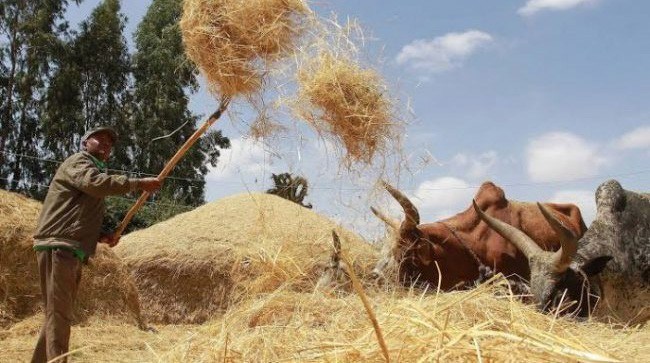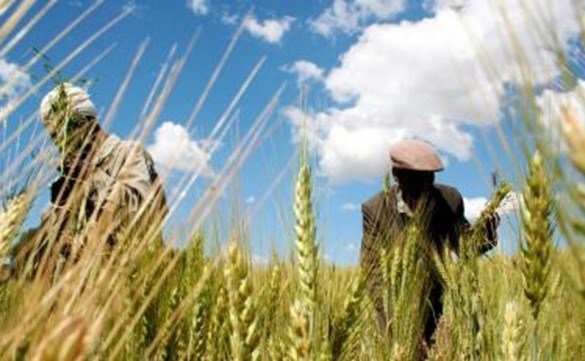Ethiopia is the third largest wheat producing country in Africa, next to Egypt and Morocco. About 1.8 million hectares (ha) of land areas are covered by wheat production with an estimated annual production of 50 million quintals at an average productivity of 28 quintals/ ha, which has been improving constantly over the past 25 years but remains lower than the world average of 33 quintals/ha.
As part of its overall commitment to boost agricultural output and ensure food security, the Government of Ethiopia has embarked on its goal to achieve wheat self-sufficiency within a period of 3-5 years by expanding production in the irrigable lowland areas and increasing productivity in the rain-fed agro-ecologies of Ethiopia.
Ethiopia is the third largest wheat producing country in Africa, next to Egypt and Morocco. About 1.8 million hectares (ha) of land areas are covered by wheat production with an estimated annual production of 50 million quintals at an average productivity of 28 quintals/ ha, which has been improving constantly over the past 25 years but remains lower than the world average of 33 quintals/ha.
Despite increasing wheat production trend in the country, the demand for it has been continuously increasing, and still falls short of satisfying the annual need of the country. The demand for wheat is growing at an average rate of 9% annually, while the local production is growing only at a rate of 7.8%. The increasing population size, changing food preference, low wheat production yield due to climate change and its related negative consequences are factors attributing to the demand and supply gap.
Over the last three years, encouraging results have been registered in increasing irrigation-based wheat production. Last year, from the 20,000 ha of irrigated wheat land, about 600,000 quintals of wheat were harvested. Currently, 5-6 million quintals of wheat are expected from the 144, 300 hectares of land cultivated in Afar, Somali, Oromia, Amhara, and SNNP regional states. Ethiopia has a potential to cultivate an additional 3.5 million ha of irrigable land in the Awash, Shebele and Omo basins. Irrigation-based wheat cultivation piloted in the lowland areas of the country is now being replicated and expanded to the highland areas.
As a temporary fix, the demand gap is being bridged by importing an average of 10-15 million quintals of wheat per annum, costing around 300-400 million USD, and putting additional pressure on already meager foreign currency reserve of the country.
Therefore, to minimize the imbalance between supply and demand for wheat, the government is heavily expanding irrigated wheat cultivation throughout the country as this enables to yield more harvest compared to the rainy fed cultivation. It is anticipated that if the average productivity of wheat is increased from 28 quintals/ha to 50 quintals/ha on the 1.8 ha of land currently being cultivated, wheat self-sufficiency can be achieved.

Credit: Ethiopian Monitor
On top of the focus on irrigated agriculture, Ethiopia is rolling-out cluster farming system at a large scale. The cluster farming system targets smallholder farmers, which are known to practice labor intensive, fragmented and subsistence farming. The cluster farming system, apart from helping small-scale farmers to increase productivity through adequate supply of modern agricultural inputs, has been facilitating for farmers to get market access by increasing quality and quantity of agricultural product for local consumption as well as export trade.
Government’s effort to scale-up cluster farming is also being supported by development partners with programs like Agricultural Commercialization Clusters (ACC). The ACC is a five-year program that’s being implemented in Amhara, Oromia, SNNP and Tigray regions and prioritizing 10 commodities in 31 clusters across the four major regions. The ACC to a large part is being funded by the European Union and its member states (Denmark and Netherlands) and targets to double the income of 5 million smallholder farmers during the five-year period (2019/20 and 2023/24).
In order to increase the crop yield and productivity of smallholder farmers, the Government is also taking steps to mechanize agricultural practices in the country, which is still heavily reliant on human labor. The cluster farming system, when coupled with mechanized production, not only helps modernize and increase productivity of the agriculture sector, but also enables intensified market-oriented production practices. Hence the agriculture sector aspires not only to bring about food self-sufficiency to the nation but also to penetrate the international market by leveraging the country’s full potential to become a large exporter of agricultural products including wheat.

